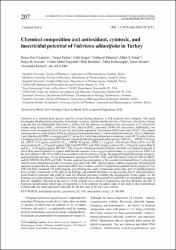| dc.contributor.author | Sen-Utsukarci, Burcu | |
| dc.contributor.author | Taskin, Turgut | |
| dc.contributor.author | Goger, Fatih | |
| dc.contributor.author | Tabanca, Nurhayat | |
| dc.contributor.author | Estep, Alden S. | |
| dc.contributor.author | Kessler, Sonja M. | |
| dc.contributor.author | Mat, Afife | |
| dc.date.accessioned | 2020-07-09T20:58:59Z | |
| dc.date.available | 2020-07-09T20:58:59Z | |
| dc.date.issued | 2019 | |
| dc.identifier.issn | 0004-1254 | |
| dc.identifier.issn | 1848-6312 | |
| dc.identifier.uri | https://doi.org/10.2478/aiht-2019-70-3273 | |
| dc.identifier.uri | https://hdl.handle.net/11421/24128 | |
| dc.description | Kiemer, Alexandra K./0000-0002-7224-9900; DAGISTAN, OZLEM AKBAL/0000-0002-6524-3535 | en_US |
| dc.description | WOS: 000489295500007 | en_US |
| dc.description | PubMed: 32597129 | en_US |
| dc.description.abstract | Valeriana is a common plant species used for various healing purposes in folk medicine since antiquity. This study investigates the phytochemical profile, antioxidant, cytotoxic, and insecticidal activity of Valeriana alliariifolia Adams, a species that has traditionally been used in Turkey. For the analyses we prepared four root extracts of V. alliariifolia Adams using hexane (HM1), chloroform (CM1), ethanol (EM1), and water (WM1) for maceration. Additionally, two extracts were also prepared from its roots by maceration separately with ethanol (EM2) and water (WM2). One sample was prepared as a water infusion (WI), according to the procedure used in Turkish traditional medicine. the 2,2-Diphenyl1-picrylhydrazyl (DPPH) scavenging and 2,2'-azino-bis(3-ethylbenzothiazoline-6-sulphonic acid (ABTS) radical cation scavenging activity tests showed that ethanol extracts had the strongest antioxidant activity: EM1 (IC50 - DPPH: 17.694 mu g/mL; ABTS: 23.8 mu g/mL) and EM2 (IC50 - DPPH: 20 mu g/mL; ABTS: 21.5 mu g/mL). the hexane extract, HM1, was the most cytotoxic (IC50<10 mu g/mL against HepG2 and HUVEC) and EM2 strongly cytotoxic (IC50<10 mu g/mL against HepG2 and IC50: 11.96 mu g/mL against HUVEC). the extracts with demonstrated cytotoxic activities were further examined to check their insecticidal activity against adult female mosquito Aedes aegypti and first instar Ae. aegypti larvae. HM1 was the most effective (90 +/- 10 %), which was consistent with its cytotoxic activity. Because of the high antioxidant, cytotoxic, and insecticidal activities, we ran phytochemical analyses of the HM1, EM1, and EM2 extracts with GC-MS (for HM1) and LC-MS/MS (for EM1 and EM2). We also analysed the composition of the essential oil obtained from V. alliariifolia roots by micro-distillation in order to compare its content with HM1, which contains volatile compounds. Phytochemical analyses revealed that the major compound in HM1 was isovaleric acid (16 %) and in the essential oil 1,8-cineole (2.9 %). EM1 and EM2 contained 5-O-caffeoylquinic acid (chlorogenic acid), verbascoside (acteoside), and 3,5-dicaffeoylquinic acid as major components. in the light of our findings and available literature, we can conclude that V. alliariifolia has a good bioactive potential that could be used for different purposes, including the development of new agents for the treatment of various diseases. the difference in the content between the essential oil and HM1 was remarkable. It suggests that the variability observed in the activity of the samples was a result of composition and that, therefore, the aim of treatment should dictate which type of preparation is to be selected. An added value of our study is that it determined verbascoside and methylquercetin rutinoside for the first time in the Valeriana extracts. | en_US |
| dc.description.sponsorship | Deployed War-Fighter Protection Research Program grants from the US Department of Defense Armed Forces Pest Management Board; US Department of Defense Armed Forces Pest Management Board | en_US |
| dc.description.sponsorship | This study was partly funded by the Deployed War-Fighter Protection Research Program grants from the US Department of Defense Armed Forces Pest Management Board. | en_US |
| dc.language.iso | eng | en_US |
| dc.publisher | Inst Medical Research & Occupational Health | en_US |
| dc.relation.isversionof | 10.2478/aiht-2019-70-3273 | en_US |
| dc.rights | info:eu-repo/semantics/openAccess | en_US |
| dc.subject | antioxidant activity | en_US |
| dc.subject | cytotoxicity | en_US |
| dc.subject | GC-MS | en_US |
| dc.subject | insecticidal activity | en_US |
| dc.subject | LC-MS/MS | en_US |
| dc.title | Chemical composition and antioxidant, cytotoxic, and insecticidal potential of Valeriana alliariifolia in Turkey | en_US |
| dc.type | article | en_US |
| dc.relation.journal | Arhiv Za Higijenu Rada I Toksikologiju-Archives of Industrial Hygiene and Toxicology | en_US |
| dc.contributor.department | Anadolu Üniversitesi | en_US |
| dc.identifier.volume | 70 | en_US |
| dc.identifier.issue | 3 | en_US |
| dc.identifier.startpage | 207 | en_US |
| dc.identifier.endpage | 218 | en_US |
| dc.relation.publicationcategory | Makale - Uluslararası Hakemli Dergi - Kurum Öğretim Elemanı | en_US |


















